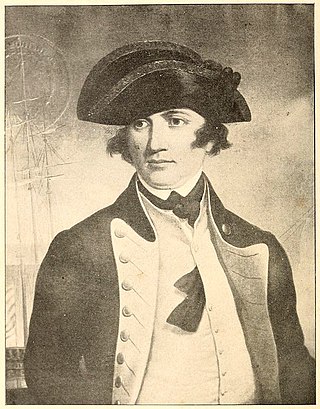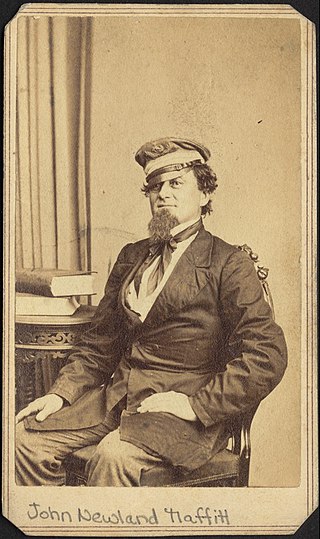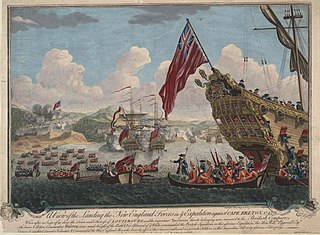
William Kidd, also known as Captain William Kidd or simply Captain Kidd, was a Scottish privateer. Conflicting accounts exist regarding his early life, but he was likely born in Dundee and later settled in New York City. By 1690, Kidd had become a highly successful privateer, commissioned to protect English interests in North America and the West Indies.

A privateer is a private person or vessel which engages in maritime warfare under a commission of war. Since robbery under arms was a common aspect of seaborne trade, until the early 19th century all merchant ships carried arms. A sovereign or delegated authority issued commissions, also referred to as letters of marque, during wartime. The commission empowered the holder to carry on all forms of hostility permissible at sea by the usages of war. This included attacking foreign vessels and taking them as prizes and taking crews prisoner for exchange. Captured ships were subject to condemnation and sale under prize law, with the proceeds divided by percentage between the privateer's sponsors, shipowners, captains and crew. A percentage share usually went to the issuer of the commission.

Fairfield is a town in Fairfield County, Connecticut, United States. It borders the city of Bridgeport and towns of Trumbull, Easton, Weston, and Westport along the Gold Coast of Connecticut. As of 2020, the town had a population of 61,512. The town is part of the Greater Bridgeport Planning Region.

Esek Hopkins was an American naval officer, merchant captain, and privateer. Achieving the rank of Commodore, Hopkins was the only Commander-in-Chief of the Continental Navy during the American Revolutionary War. The Continental Congress commissioned him as Commander-in-Chief of the Navy in December 1775.

The Penobscot Expedition was a 44-ship American naval armada during the Revolutionary War assembled by the Provincial Congress of the Province of Massachusetts Bay. The flotilla of 19 warships and 25 support vessels sailed from Boston on July 19, 1779, for the upper Penobscot Bay in the District of Maine carrying an expeditionary force of more than 1,000 American colonial marines and militiamen. Also included was a 100-man artillery detachment under the command of Lt. Colonel Paul Revere.
Seth Harding was an officer in the United States Navy during the American Revolutionary War. In 1776, he was the captain of the Defence.

Joshua Barney was an American Navy officer who served in the Continental Navy during the Revolutionary War and as a captain in the French Navy during the French Revolutionary Wars. He later achieved the rank of commodore in the United States Navy and also served in the War of 1812.

John Newland Maffitt was an officer in the Confederate States Navy who was nicknamed the "Prince of Privateers" due to his success as a blockade runner and commerce raider in the U.S. Civil War.

Colonel Simeon Perkins was a Nova Scotia militia leader, merchant, diarist and politician. Perkins led the defence of Liverpool from attacks during the American Revolution, French Revolutionary Wars and the Napoleonic Wars. In the 1770s, Liverpool was the second-largest settlement in Nova Scotia, next to Halifax. He also funded privateer ships in defence of the colony. He wrote a diary for 46 years (1766–1812), which is an essential historic document of this time period in Nova Scotian history. His home is now the Perkins House Museum. He was the grandfather of Joshua Newton Perkins.
Henry Jennings was an English privateer-turned-pirate. Jennings' first recorded act of piracy took place in early 1716 when, with three vessels and 150–300 men, Jennings' fleet ambushed the Spanish salvage camp from the 1715 Treasure Fleet. After the Florida raid, Jennings and his crew also linked up with Benjamin Hornigold's "three sets of pirates" from New Providence Island.
David Hawley (1741–1807) was a captain in the Continental Navy and a privateer during the American Revolutionary War. He commanded Royal Savage in the 1776 Battle of Valcour Island, which is generally regarded as one of the first naval battles of the American Revolutionary War, and one of the first fought by the United States Navy.

The siege of Louisbourg took place in 1745 when a New England colonial force aided by a British fleet captured Louisbourg, the capital of the French province of Île-Royale during the War of the Austrian Succession, known as King George's War in the British colonies.

The Pequonnock River is a 16.7-mile-long (26.9 km) waterway in eastern Fairfield County, Connecticut. Its watershed is located in five communities, with the majority of it located within Monroe, Trumbull, and Bridgeport. The river has a penchant for flooding, particularly in spring since the removal of a retention dam in Trumbull in the 1950s. There seems to be a sharp difference of opinion among historians as to just what the Indian word Pequonnock signifies. Some insist it meant cleared field or open ground; others are sure it meant broken ground; while a third group is certain it meant place of slaughter or place of destruction.

The Raid on Lunenburg occurred during the American Revolution when the US privateer, Captain Noah Stoddard of Fairhaven, Massachusetts, and four other privateer vessels attacked the British settlement at Lunenburg, Nova Scotia on July 1, 1782. The raid was the last major privateer attack on a Nova Scotia community during the war.

Nathaniel Saltonstall (1727–1807) was a Connecticut militiaman and a captain of Connecticut naval privateer ships during the American Revolutionary War.
Captain Sir Rupert George, 1st Baronet was a British naval officer in the American Revolution, became the Commodore for the Royal Navy's North America Station (1792-1794). He then returned to England and became the first Commissioner of the Transport Service, where he stayed for 22 years.

Captain Noah Stoddard (1755–1850) of Fairhaven, Massachusetts was an American privateer who distinguished himself during the American Revolution by leading the Raid on Lunenburg (1782). In the raid, Stoddard led four other privateer vessels and attacked the British settlement at Lunenburg, Nova Scotia on July 1, 1782. In Nova Scotia, the assault on Lunenburg was the most spectacular raid of the war.

HMS Blonde was a 32-gun fifth-rate warship of the British Royal Navy captured from the French in 1760. The ship wrecked on Blonde Rock with American prisoners on board. An American privateer captain, Daniel Adams, rescued the American prisoners and let the British go free. The captain's decision created an international stir. Upon returning to Boston, the American privateer was banished for letting go the British crew and he and his family became Loyalist refugees in Nova Scotia.

The Raid on Annapolis Royal took place on 29 August 1781 during the American Revolutionary War. The raid involved two American privateers - the Resolution and the Reprisal - attacking and pillaging Annapolis Royal, Nova Scotia in revenge of the defeat of the Penobscot Expedition. The privateers took captive the commander of the militia John Ritchie, described as the "Governor of Annapolis." One historian described it as "one of the most daring and dramatic raids upon Nova Scotia."

The Province of Nova Scotia was heavily involved in the American Revolutionary War (1776–1783). At that time, Nova Scotia also included present-day New Brunswick until that colony was created in 1784. The Revolution had a significant impact on shaping Nova Scotia, "almost the 14th American Colony". At the beginning, there was ambivalence in Nova Scotia over whether the colony should join the Americans in the war against Britain. Largely as a result of American privateer raids on Nova Scotia villages, as the war continued, the population of Nova Scotia solidified their support for the British. Nova Scotians were also influenced to remain loyal to Britain by the presence of British military units, judicial prosecution by the Nova Scotia Governors and the efforts of Reverend Henry Alline.














